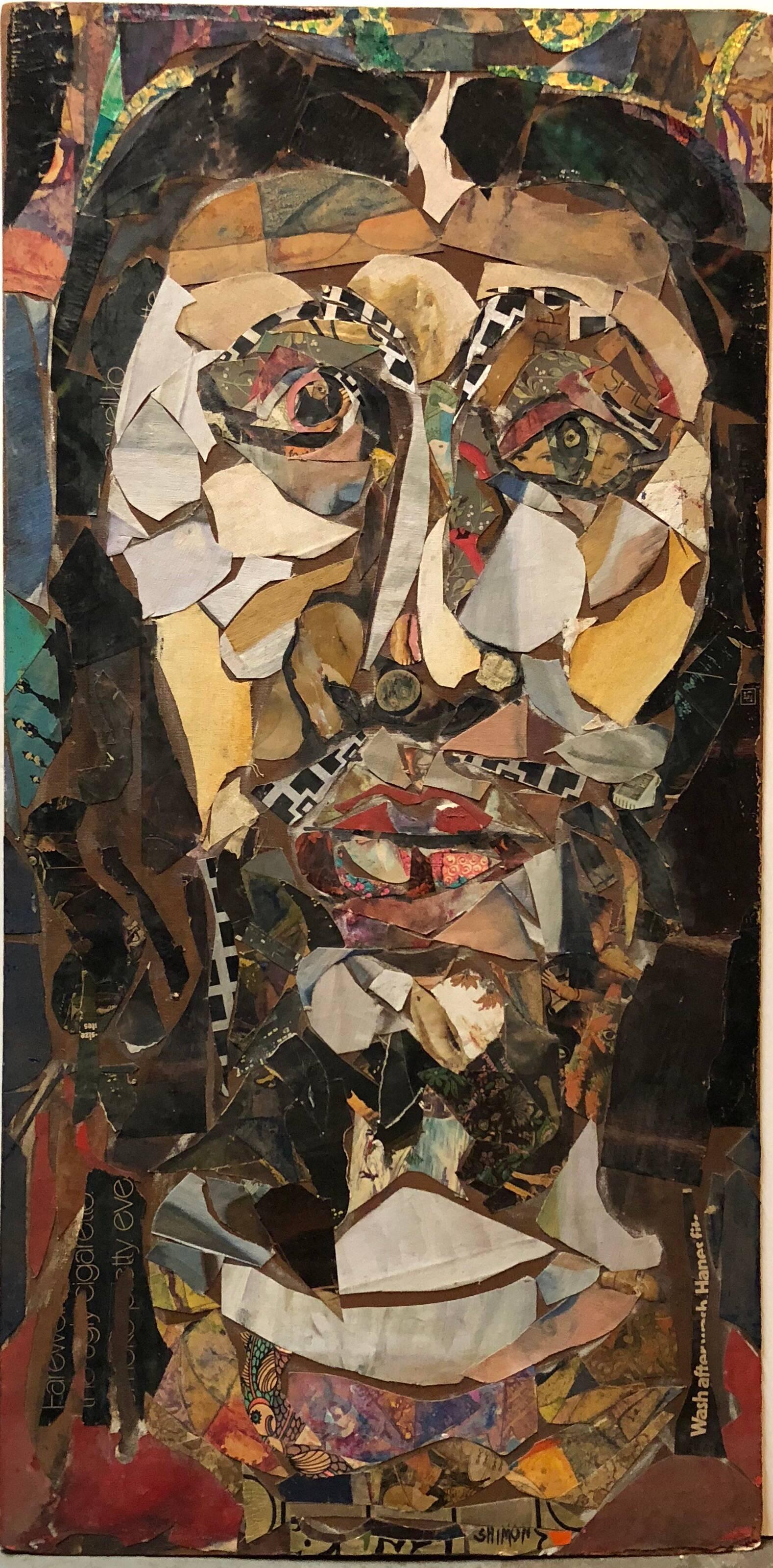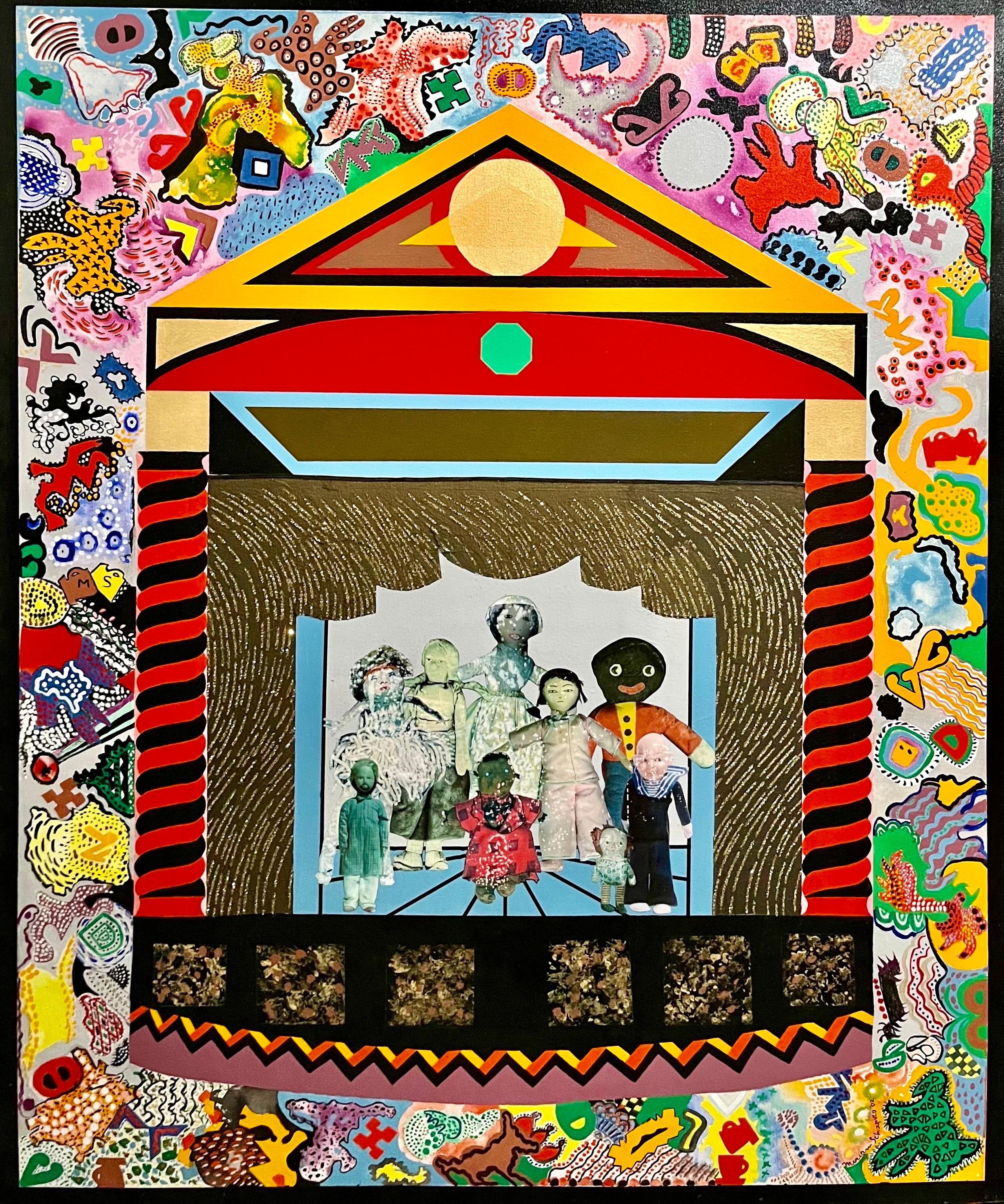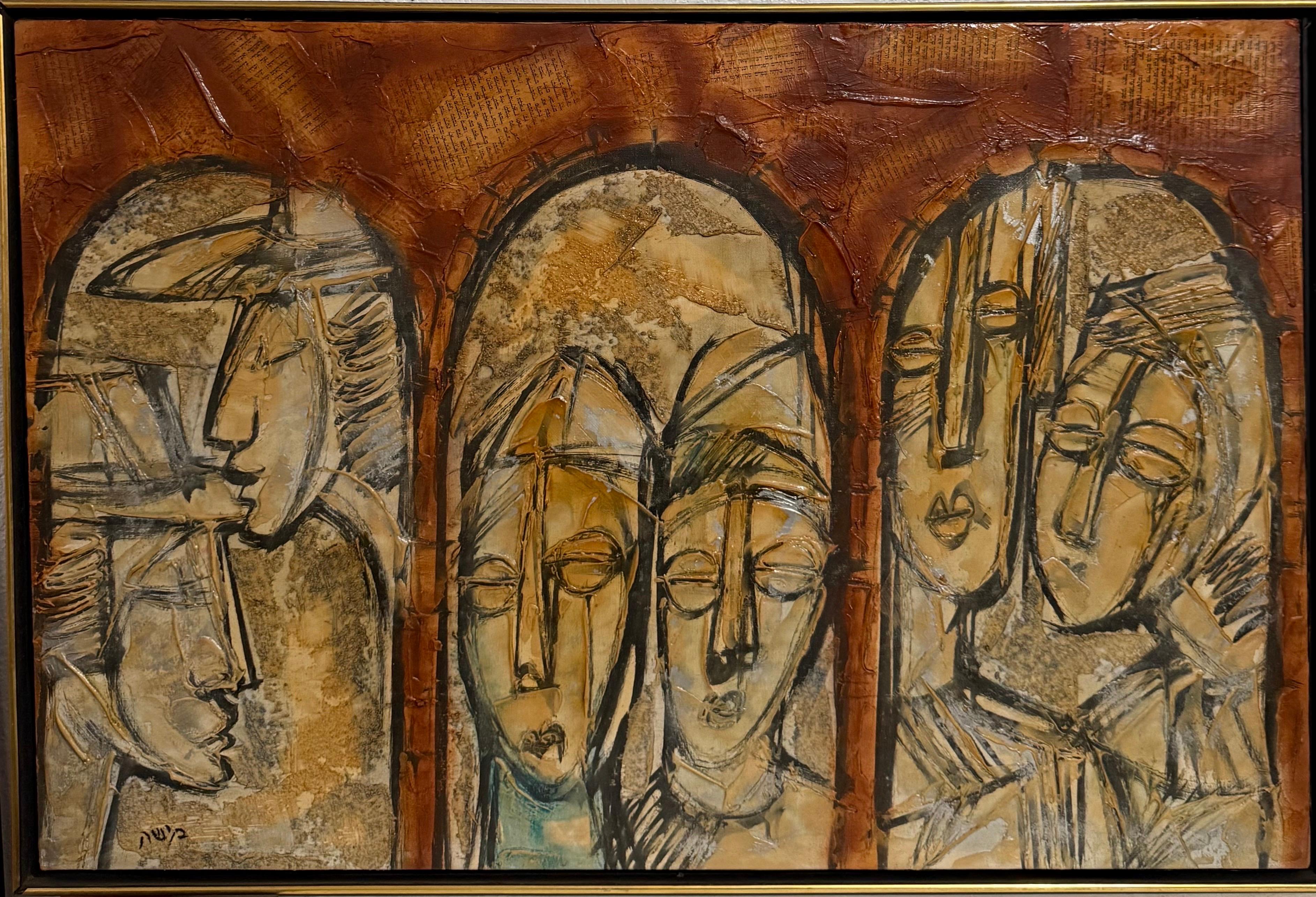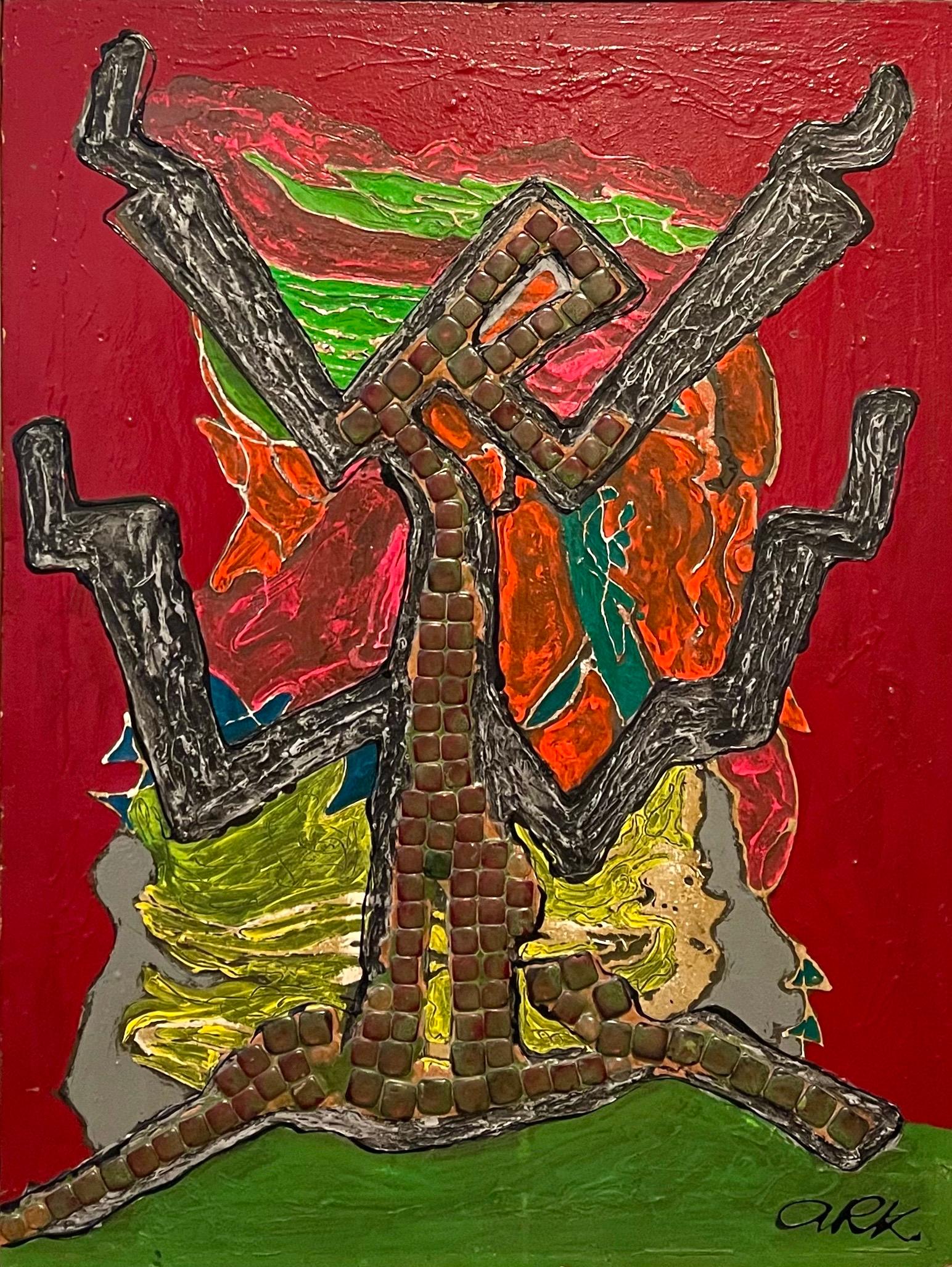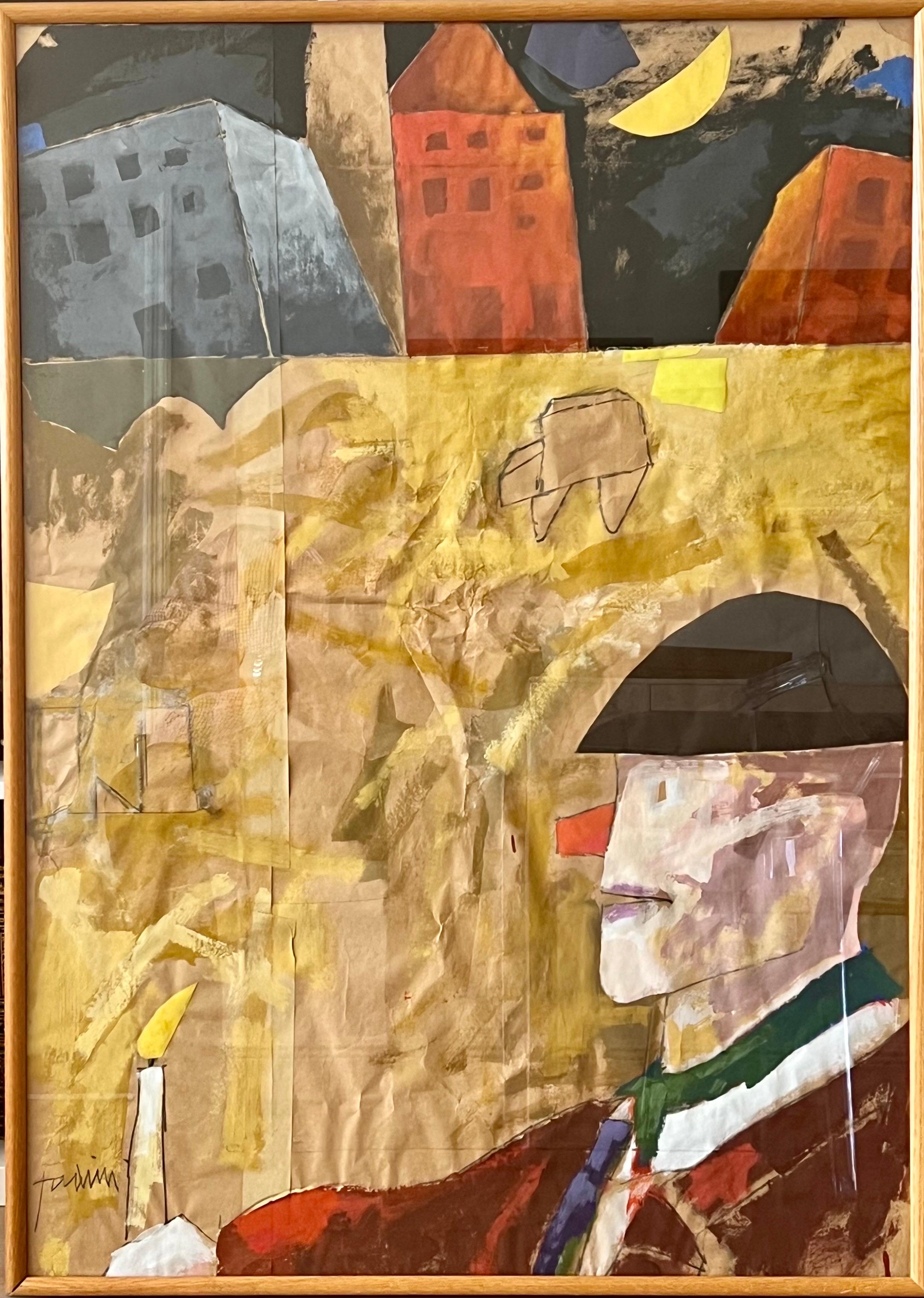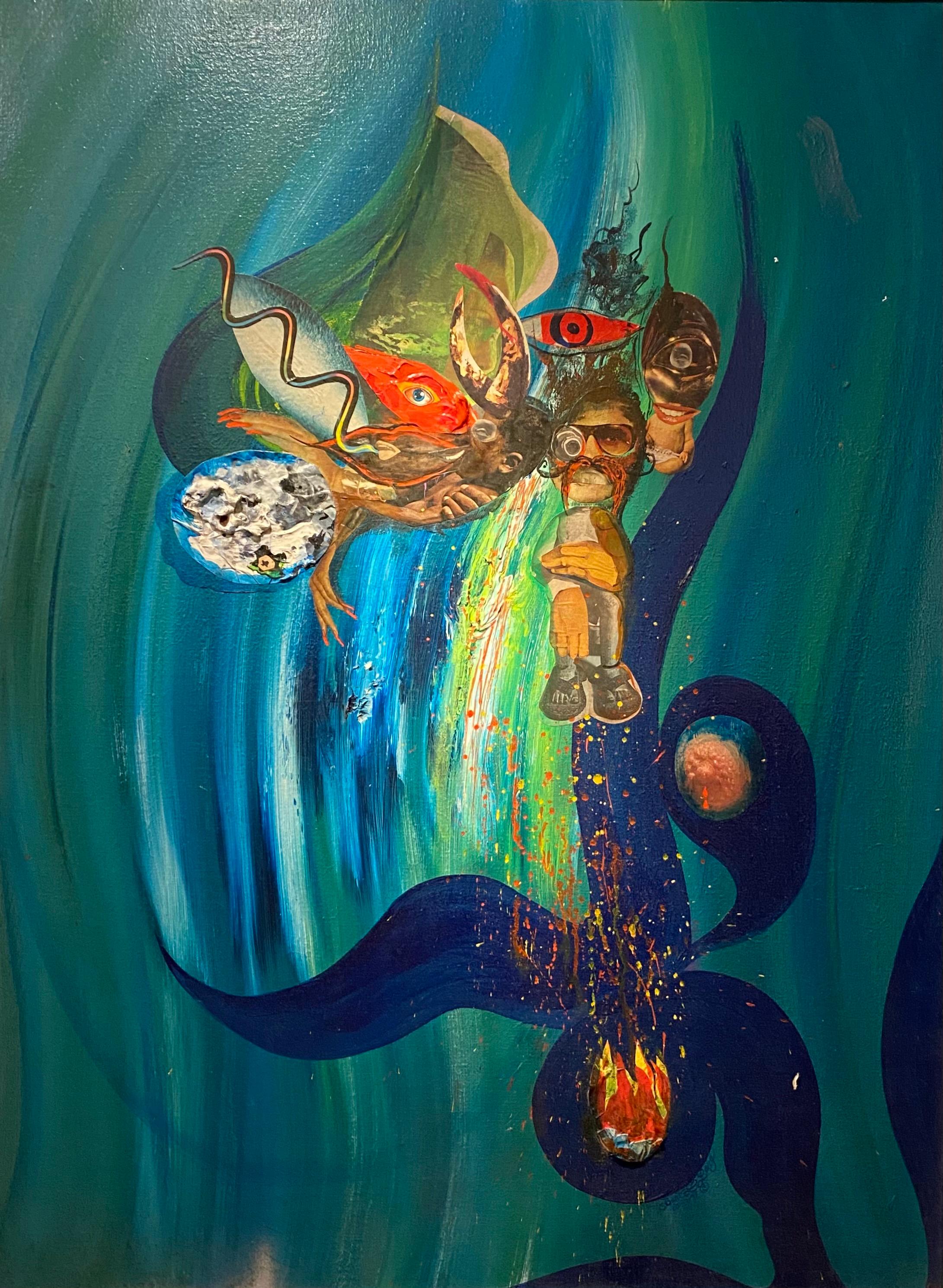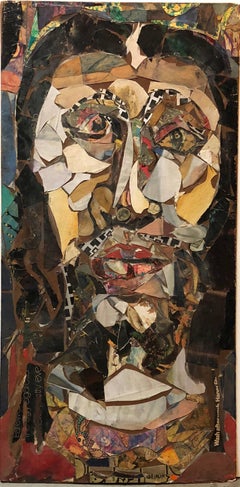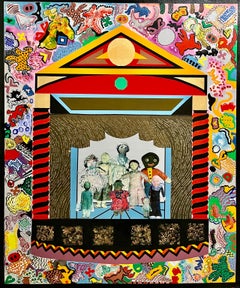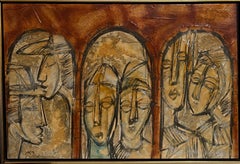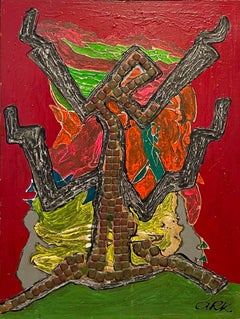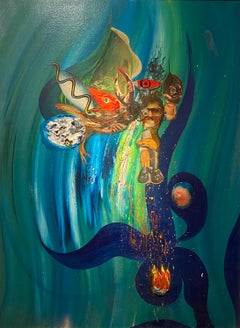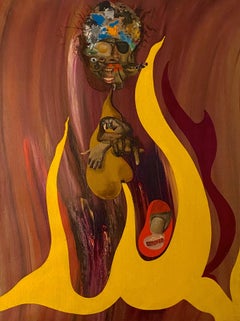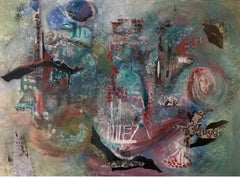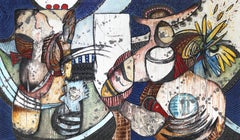Items Similar to Tribe of Benjamin, Large Judaica Mixed Media Collage Painting
Want more images or videos?
Request additional images or videos from the seller
1 of 8
Archie RandTribe of Benjamin, Large Judaica Mixed Media Collage Paintingc.1980s
c.1980s
$1,800
£1,375.02
€1,579.90
CA$2,573.61
A$2,835.52
CHF 1,467.84
MX$34,140.42
NOK 18,586.38
SEK 17,460.73
DKK 11,795.93
About the Item
Tribe of Benjamin, Biblical mural with wolf. I believe this is a study for a stained glass window. Untitled, mixed media on paper, signed lower left, inscribed "To my dear friend David lower left, overall (with frame): 54"h x 29.5"w. Provenance: The David C. and Sarajean Ruttenberg Collection (Chicago, IL)
Archie Rand (American, born 1949) is an artist from Brooklyn, New York.
Rand's work as a painter and muralist is held in the collections of the San Francisco Museum of Modern Art, the Art Institute of Chicago, the Victoria and Albert Museum in London, the Bibliothèque Nationale de France in Paris, and the Tel Aviv Museum of Art.
His graphic works and books are held by the Metropolitan Museum Of Art, the Museum of Modern Art, the Whitney Museum of American Art, the Art Institute Of Chicago, The Brooklyn Museum, the Baltimore Museum of Art, the Smithsonian Institution, and The New York Public Library; and are owned by Harvard, Yale, Columbia, Brown, and Johns Hopkins universities.
Born in Brooklyn, Rand received a Bachelor of Fine Arts in cinegraphics from the Pratt Institute, having studied previously at the Art Students League of New York.
His first exhibition was in 1966, at the Tibor de Nagy Gallery in New York. He has since had over 100 solo exhibitions, and his work has been included in over 200 group exhibitions.
He is currently Presidential Professor of Art at Brooklyn College which granted him the Award for Excellence in Creative Achievement in 2016. Before joining Brooklyn College, Rand was the chair of the Department of Visual Arts at Columbia University.
The Italian Academy For Advanced Studies in America at Columbia University presented him with The Siena Prize in 1995. He was awarded a Guggenheim Foundation Foundation Fellowship in 1999 and was made a Laureate of the National Foundation for Jewish Culture, which awarded him the Achievement Medal for Contributions in the Visual Arts. In 2002 he received the Presidential Award for Excellence in Teaching from Columbia University.
In 2002 he became the artistic advisor to film director Ang Lee for his production of The Hulk, and was asked by Milestone Films to provide a commentary track for the DVD release of Henri-Georges Clouzot’s classic 1955 film The Mystery of Picasso.
Archie Rand’s earliest major works are “The Letter Paintings” (or “The Jazz Paintings”) (1968–71), a radically positioned series of technically inventive, mural-sized canvases. The Letter Paintings, by incorporating the names of mainly male and female African-American musicians, undermined prevailing aesthetic categories by conflating many contemporary movements including Conceptual Art, Color Field, Pattern and Decoration, diary entry and social commentary.
In 1974 Rand received a commission from Congregation B’nai Yosef in Brooklyn. Rand was asked to paint thematic murals on the complete 16,000-square-foot (1,500 m2) interior surfaces of the synagogue. The work took three years, and completing this commission made Rand the author of the only narratively painted synagogue in the world and the only one we know of since the 2nd Century Dura-Europos. The religious legal controversy raised by placing wall paintings in a traditionally iconoclastic space was resolved by the verdict of Rabbi Moshe Feinstein, then considered to be the world’s leading Talmudic scholar, who declared the paintings to be in conformity with the law. His subsequent turn to figuration may have been influenced by his friendship with Philip Guston, whose own work was transformed in the late 1960s. Like Guston, Rand "chafed at the limitations of purely abstract forms."
A near-cult figure who started out as a child prodigy and whose admirers range from John Ashbery to Julian Schnabel. Rand’s paintings display a vast and savvy menu of inventive and finely executed approaches. He has completed many series after the works of Paul Celan, Moyshe-Leyb Halpern, Eugenio Montale, Yehuda Amichai, Rainer Maria Rilke, Samuel Beckett/Paul Eluard and Jack Spicer. Working often with poets, he has produced books and continues to engage in publishing collaborative projects. He maintained a correspondence with the American British Jewish painter R.B. Kitaj.I
In 2008, on a warehouse wall, Rand mounted the painting, “The 613”, which at 1700 square feet (17’ x 100’) is nearly twice the size of James Rosenquist’s F-111. It is one of the largest freestanding paintings ever made. Reminiscent of “The Segments” paintings it is intimidatingly enormous. Paradoxically, despite the raucous cartoony bytes that shoot colorful flashes from the manic surface, “The 613” glows warmly. Its overall effect is strangely calming and majestic.
In an article on a 2011 exhibition of Rand's "Had Gadya" series, David Kaufmann wrote:
Rand displayed his work in 15 solo exhibitions between 2008 and 2017, many of them showcasing paintings done after Scripture, or his workings with poets: Including “Had Gadya, 2005”, Borowsky Gallery, Philadelphia, PA (2011); “Gods Change, Prayers Are Here To Stay (after Yehuda Amichai), 2000", Katz Gallery, Atlanta, GA (2014); “Psalm 68, 1994”, Derfner Museum, Riverdale, NY (2014); “The Chapter Paintings”, Tribeca Gallery, NY (2015); “Men Who Turn Back (after Eugenio Montale), 1995", SRO Gallery, Brooklyn, NY (2016); “Sixty Paintings From the Bible” & “The Book of Judith, 2012”, Cleveland State University Galleries, Cleveland, OH (2016) & The American Jewish Museum, Pittsburgh, PA (2017); “Archie Rand: Early Works With Poetry: Jack Spicer, 1991 and Samuel Beckett/Paul Eluard, 1993”, St. Francis College, Brooklyn, NY (2017).
"The 613"
In 2015 Blue Rider/Penguin/Random House published The 613, allotting one color plate per page for each of the 614 units in the painting. The Wall Street Journal labeled The 613 as “dynamic…remarkable…thrilling” The New York Times selected the book as “Editors' Choice” and praised it in two separate reviews calling it “wonderfully garish” and declaring that “nothing prepared the art world for 'The 613.'
Recent Activity
The 2016 exhibition “Sixty Paintings From The Bible” at The Galleries at Cleveland State University produced a scholarly book about those paintings, written by Samantha Baskind and published by CSU. In 2016 Rand showed two bodies of work that were done in Italy, “La Certosa Di Pontignano, 1995” and “Mount Etna, 2005,” at The Interchurch Center Galleries, New York. From 2016 to 2017 he served as the Curator and Juror for the Governor of Wyoming’s Capitol Arts Exhibition at The Wyoming State Museum, Cheyenne, WY.
A 2017 exhibition, “Archie Rand: Early Works With Poetry”, featured two series of work from 1991 and 1993 after poems by Jack Spicer and Samuel Beckett/Paul Eluard.
- Creator:Archie Rand (1949, American)
- Creation Year:c.1980s
- Dimensions:Height: 54 in (137.16 cm)Width: 29.5 in (74.93 cm)
- Medium:
- Movement & Style:
- Period:
- Condition:paper has waving. i believe original to the iece and technique.
- Gallery Location:Surfside, FL
- Reference Number:1stDibs: LU38212597922
About the Seller
4.9
Platinum Seller
Premium sellers with a 4.7+ rating and 24-hour response times
Established in 1995
1stDibs seller since 2014
1,817 sales on 1stDibs
Typical response time: 1 hour
- ShippingRetrieving quote...Shipping from: Surfside, FL
- Return Policy
Authenticity Guarantee
In the unlikely event there’s an issue with an item’s authenticity, contact us within 1 year for a full refund. DetailsMoney-Back Guarantee
If your item is not as described, is damaged in transit, or does not arrive, contact us within 7 days for a full refund. Details24-Hour Cancellation
You have a 24-hour grace period in which to reconsider your purchase, with no questions asked.Vetted Professional Sellers
Our world-class sellers must adhere to strict standards for service and quality, maintaining the integrity of our listings.Price-Match Guarantee
If you find that a seller listed the same item for a lower price elsewhere, we’ll match it.Trusted Global Delivery
Our best-in-class carrier network provides specialized shipping options worldwide, including custom delivery.More From This Seller
View AllLarge Assemblage Collage 2 Sided Painting Outsider Art
By Paul Shimon
Located in Surfside, FL
Born in New York, Paul Shimon (1919 - 2011) was both an accomplished artist and composer.
Considered by some to be an Early Outsider artist, Shimon studied at the Art Students Leag...
Category
Late 20th Century Abstract Figurative Drawings and Watercolors
Materials
Mixed Media
Large Mixed Media Collage Painting Great Jewish Feminist Artist Miriam Schapiro
By Miriam Schapiro
Located in Surfside, FL
Miriam Schapiro,
"Curtain Call"
2002
Hand signed, dated and titled verso and signed and dated recto.
acrylic paint, digital images, glitter and textile fabric on canvas, tooling with gold leaf embossing around self edge of painting.
size: 60 x 50 in
Miriam Schapiro (or Mimi Schapiro) (November 15, 1923 – June 20, 2015) was a Canadian-born artist based in America. She was a painter, sculptor and printmaker. She was a pioneer of feminist art. She was also considered a leader of the Pattern and Decoration art movement. Schapiro's artwork blurs the line between fine art and craft. Her paintings contain craft elements because crafts and decoration is associated with women and femininity. She used icons that are associated with women such as hearts, floral decorations, geometric patterns and the color pink. In the 1970s she made a small woman's object, the fan, heroic by painting it six feet by twelve feet. This bears the influence of the Pattern and Decoration movement artists such as Brad Davis, Mary Grigoriadis, Joyce Kozloff, Robert Kushner, Kim MacConnel, Sonya Rapoport, Miriam Schapiro and Valerie Jaudon. Shapiro was born in Toronto, Ontario, Canada. Her father was an industrial design artist who fostered her desire to be an artist and served as her role model and mentor. Her mother was a stay at home mother who worked part-time during the depression.
As a teenager, Schapiro was taught by Victor d’Amico, her first modernist teacher at the Museum of Modern Art. In the evenings she joined WPA classes for adults to study drawing from the nude model. In 1943, Schapiro entered Hunter College in New York City, but eventually transferred to the University of Iowa. At the University of Iowa, Schapiro studied painting with Stuart Edie and James Lechay. She studied printmaking under Mauricio Lasansky and was his personal assistant, which then led her to help form the Iowa Print Group. Lasanky taught his students to use several different printing techniques in their work and to study the masters' work in order to find solutions to technical problems.
At the State University of Iowa she met the artist Paul Brach, whom she married in 1946.. By 1951 they moved to New York City and befriended many of the Abstract expressionist artists of the New York School, including Joan Mitchell, Larry Rivers, Knox Martin and Michael Goldberg.
Schapiro worked in the style of Abstract expressionism during this time period. Shapiro and Brach lived in New York City during the 1950s and 1960s. During this period Shapiro had a successful career as an abstract expressionist painter in the hard-edge style. In December 1957, André Emmerich selected one of her paintings for the opening of his gallery. Schapiro not only honored the craft tradition in women's art, but also paid homage to women artists of the past. In the early 1970s she made paintings and collages which included photo reproductions of Mary Cassatt's and Georgia O'keefe's paintings. Early in her career, Schapiro started looking for maternal symbols to unify her own roles as a woman. Her series, Shrines (1963), was her first artistically successful attempt at compartmentalizing her life roles. Her painting, Big Ox No. 1, from 1968, references Shrines, however no longer compartmentalized. The center O takes on the symbol of the egg which exists as the window into the maternal structure with outstretched limbs. Her series, Shrines was created in 1961–63. It is one of her earliest group of work that was also an autobiography. Each section of the work show an aspect of being a woman artist. They are also symbolic of her body and soul.
In 1964 Schapiro and her husband Paul both worked at the Tamarind Lithography Workshop. One of Schapiro's biggest turning points in her art career was working at the workshop and experimenting with Josef Albers' Color-Aid paper, where she began making several new shrines and created her first collages.
In the 1970s, Schapiro and Brach moved to California so that both could teach in the art department at the University of California. Subsequently, she was able to establish the Feminist Art Program at the California Institute of the Arts, in Valencia with Judy Chicago. The program set out to address the problems in the arts from an institutional position. They wanted the creation of art to be less of a private, introspective adventure and more of a public process through consciousness raising sessions, personal confessions and technical training. She participated in the Womanhouse exhibition in 1972. Schapiro's smaller piece within Womanhouse, called "Dollhouse", was constructed using various scrap pieces to create all the furniture and accessories in the house. Each room signified a particular role a woman plays in society and depicted the conflicts between them. Along with Nancy Spero, Joan Snyder, Joyce Kozloff, Audrey Flack and Judy Chicago, she is from that first generation of Jewish American feminist women artists and includes Judaica in her work.
Schapiro's work from the 1970s onwards consists primarily of collages assembled from fabrics, which she called "femmages". As Schapiro traveled the United States giving lectures, she would ask the women she met for a souvenir. These souvenirs would be used in her collage like paintings. Her 1977-1978 essay Waste Not Want Not: An Inquiry into What Women Saved and Assembled - FEMMAGE (written with Melissa Meyer) describes femmage as the activities of collage, assemblage, découpage and photomontage practised by women using "traditional women's techniques - sewing, piercing, hooking, cutting, appliquéing, cooking and the like..."
She was involved in Abstract expressionism, Minimalism, Computer art, and Feminist art. She worked with collage, printmaking, painting, femmage [fr] – using women's craft in her artwork, and sculpture. Schapiro not only honored the craft tradition in women's art, but also paid homage to women artists of the past. In the early 1970s she made paintings and collages which included photo reproductions of past artists such as Mary Cassatt. In the mid 1980s she painted portraits of Frida Kahlo on top of her old self-portrait paintings. In the 1990s Schapiro began to include women of the Russian Avant Garde in her work. The Russian Avant Garde was an important moment in Modern Art history for Schapiro to reflect on because women were seen as equals.
Schapiro also did collaborative art projects, like her series of etchings Anonymous was a Woman from 1977. She was able to produce the series with a group of nine women studio-art graduates from the University of Oregon. Each print is an impression made from an untransformed doily that was placed in soft ground on a zinc plate, then etched and printed.
Her image is included in the iconic 1972 poster Some Living American Women Artists by Mary Beth Edelson...
Category
Early 2000s Contemporary Mixed Media
Materials
Glitter, Mixed Media, Fabric, Acrylic, Digital
Modernist Israeli Judaica Jewish Rabbi Mixed Media Collage Painting Moshe Katz
By Moshe Katz
Located in Surfside, FL
Rabbis, Jewish Scholars over collaged Hebrew text
Dimensions: framed 37.5 X 25.25 canvas 24 X 36 inches
Moshe Katz ( Romanian, Israeli ) Moshe Katz was born March 2 1937 in
Buchar...
Category
20th Century Modern Portrait Paintings
Materials
Canvas, Mixed Media, Acrylic
Chicago Jewish Modernist Mixed Media Surrealist Painting WPA Artist Mosaic Tiles
By Alexander Raymond Katz
Located in Surfside, FL
Alexander Raymond Katz (Hungarian-American, 1895-1974)
initialed l.r. "A.R.K."
inscribed verso "Prayer Tree", A Raymond Katz."
Sight size: 39-3/4"h x 30"...
Category
Mid-20th Century Modern Abstract Paintings
Materials
Mixed Media, Alkyd, Board
Italian Pop Art Mixed Media Surrealist Painting Collage Gouache Emilio Tadini
By Emilio Tadini
Located in Surfside, FL
Emilio Tadini (1927-2002)
Original Collage, Gouache and Watercolor painting.
Dimensions: 41 X 29.5. framed. 39.75 X 28 artwork
Emilio Tadini (1927 – 2002 ) was an Italian painter,...
Category
20th Century Surrealist Mixed Media
Materials
Paint, Paper, Mixed Media, Watercolor, Gouache
TOAST TO THE BAR MITZVA Modernist Judaica Oil Painting
By Joseph Wolins
Located in Surfside, FL
Subject: Jewish American Family Bar Mitzvah with Rabbi
Medium: Oil
Surface: Canvas
Country: United States
In this painting, Joseph Wolins uses vibrant and complimentary colors and...
Category
20th Century American Modern Figurative Paintings
Materials
Canvas, Oil
You May Also Like
"Untitled, " Acrylic and Paper Collage on Canvas
Located in Houston, TX
This work was one of Long’s earliest compositions as an artist. Even earlier in his artistic career, Long was interested in exploring the intersection of various media, branching out into new innovative spaces. This work demonstrates the technique and forms at play that have since germinated into Long’s signature style.
Bert L. Long Jr., was self-taught artist, was born in 1940 in Texas, grew up the Houston’s historic Fifth Ward and received his formal education from UCLA. Following a career as a successful master chef, Long decided to devote himself entirely to art in the late 1970’s. He began to explore folk art and assemblage to create a unique body of work, attracting the attention of Jim Harithas, then Director of the Contemporary Arts Museum Houston, and artists John Alexander, Salvatore Scarpitta and James Surls. His life spanned an era of radical change in the American social climate, the influence of which can be seen clearly in his work.
Long’s paintings and sculptures incorporate a high level of skill and sophisticated knowledge of art history, along with complex philosophical and social issues. Long describes the philosophy behind his work as "a quest to help people diagnose their inner self," believing his art to be "the vehicle to help facilitate the process."
“As artists we have the obligation to provide the world with art which communicates as truth. I believe that art has the power to heal our souls of their afflictions. I try to create art which helps to diagnose the prevalent conditions within our societies, hopefully providing an insightfulness which will help us all become brothers and sisters united in equality and compassion”
- Bert L. Long, Jr.
The late Peter Marzio, former Director of the Museum of Fine Arts, Houston, said of Bert Long during the major retrospective of Long’s work at the museum:
“Bert Long does not avert his gaze from that which is painful, but as [his artworks] testify, he also brings a spirit of joy and redemption to his art. We can all learn from this great artist.”
Over Long’s 33-year career as a painter, sculptor, and photographer, he had several solo exhibitions at respected museums and was awarded many significant awards including the National Endowment for the Arts Grant in 1987 and the prestigious international Prix de Rome fellowship in 1990. Other notable awards of Long’s include the Texas Accountants and Lawyers for the Arts Artist of the Year Award in 2009, the Adolph and Esther Gottlieb Foundation Emergency Assistance Grant in 1997, the Houston Art League Texas Artist of the Year in 1990, the NEA Visual Artists Fellowship Grant, 1987 and the Bemis Foundation Residency in 1998. His work can be seen in over 100 private and public collections worldwide, including the Metropolitan Museum of Art, New York, the Dallas Museum of Art, the Houston Museum of Fine Art, the Blanton Museum of Art, Austin, the El Paso Museum of Art, and the Instituto de Bachillerato in Spain.
With a recent solo exhibition at the Houston Museum of African American Culture and an exhibition overseas which is pending featuring his work, plus interest from several national museums, Bert L. Long Jr. continues to be recognized as an important African American artist throughout Texas, nationally and internationally.
Bert L. Long, Jr.
"Untitled"
1977
Acrylic and Paper Collage on Canvas...
Category
1970s Contemporary Figurative Paintings
Materials
Canvas, Acrylic
Price Upon Request
"Untitled, " Acrylic and Paper Collage on Canvas
Located in Houston, TX
This work was one of Long’s earliest compositions as an artist. Even earlier in his artistic career, Long was interested in exploring the intersection of various media, branching out into new innovative spaces. This work demonstrates the technique and forms at play that have since germinated into Long’s signature style.
Bert L. Long Jr., was self-taught artist, was born in 1940 in Texas, grew up the Houston’s historic Fifth Ward and received his formal education from UCLA. Following a career as a successful master chef, Long decided to devote himself entirely to art in the late 1970’s. He began to explore folk art and assemblage to create a unique body of work, attracting the attention of Jim Harithas, then Director of the Contemporary Arts Museum Houston, and artists John Alexander, Salvatore Scarpitta and James Surls. His life spanned an era of radical change in the American social climate, the influence of which can be seen clearly in his work.
Long’s paintings and sculptures incorporate a high level of skill and sophisticated knowledge of art history, along with complex philosophical and social issues. Long describes the philosophy behind his work as "a quest to help people diagnose their inner self," believing his art to be "the vehicle to help facilitate the process."
“As artists we have the obligation to provide the world with art which communicates as truth. I believe that art has the power to heal our souls of their afflictions. I try to create art which helps to diagnose the prevalent conditions within our societies, hopefully providing an insightfulness which will help us all become brothers and sisters united in equality and compassion”
- Bert L. Long, Jr.
The late Peter Marzio, former Director of the Museum of Fine Arts, Houston, said of Bert Long during the major retrospective of Long’s work at the museum:
“Bert Long does not avert his gaze from that which is painful, but as [his artworks] testify, he also brings a spirit of joy and redemption to his art. We can all learn from this great artist.”
Over Long’s 33-year career as a painter, sculptor, and photographer, he had several solo exhibitions at respected museums and was awarded many significant awards including the National Endowment for the Arts Grant in 1987 and the prestigious international Prix de Rome fellowship in 1990. Other notable awards of Long’s include the Texas Accountants and Lawyers for the Arts Artist of the Year Award in 2009, the Adolph and Esther Gottlieb Foundation Emergency Assistance Grant in 1997, the Houston Art League Texas Artist of the Year in 1990, the NEA Visual Artists Fellowship Grant, 1987 and the Bemis Foundation Residency in 1998. His work can be seen in over 100 private and public collections worldwide, including the Metropolitan Museum of Art, New York, the Dallas Museum of Art, the Houston Museum of Fine Art, the Blanton Museum of Art, Austin, the El Paso Museum of Art, and the Instituto de Bachillerato in Spain.
With a recent solo exhibition at the Houston Museum of African American Culture and an exhibition overseas which is pending featuring his work, plus interest from several national museums, Bert L. Long Jr. continues to be recognized as an important African American artist throughout Texas, nationally and internationally.
Bert L. Long, Jr.
"Untitled"
1977
Acrylic and Paper Collage on Canvas...
Category
1970s Contemporary Figurative Paintings
Materials
Canvas, Acrylic
Price Upon Request
Temple of the Gods - Abstract Mixed Media Painting - Les Taylor
Located in Carmel, CA
Les Taylor is an artist who has embraced a lifelong love for both music and art. Over the past decade, Les's dedication to painting has grown exponentially. In the sanctuary of her s...
Category
2010s Contemporary Abstract Paintings
Materials
Canvas, Mixed Media, Acrylic
The Struggle is Real - Large Colorful Original Abstract Painting on Canvas
By Bruce Rubenstein
Located in Los Angeles, CA
The paintings of Bruce Rubenstein seamlessly marry sophistication with affordability. His original art merges the creative attitudes of the two distinct art hot spots of New York and...
Category
21st Century and Contemporary Abstract Mixed Media
Materials
Canvas, Mixed Media, Acrylic
ABACAB - Large Original Abstract Expressionism Colorful Mixed Media Painting
By Bruce Rubenstein
Located in Los Angeles, CA
The paintings of Bruce Rubenstein seamlessly marry sophistication with affordability. His original art merges the creative attitudes of the two distinct art hot spots of New York and...
Category
21st Century and Contemporary Abstract Mixed Media
Materials
Canvas, Charcoal, Oil Pastel, Mixed Media, Acrylic
"Wall of the Carry Outs, " Abstract Acrylic Collage signed by Joseph Rozman
By Joseph Rozman
Located in Milwaukee, WI
"Wall of the Carry Outs" is Wisconsin artist Joseph Rozman's 1968 signed acrylic collage.
36" x 29 1/2" art size
Joseph Rozman was born on December 26, 1944 in Milwaukee, WI. Rozma...
Category
1960s Contemporary Mixed Media
Materials
Acrylic
